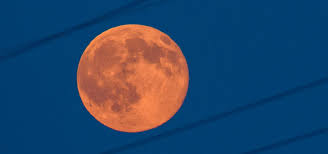
The full moon of June, also called the Strawberry Moon, will occur the morning of Friday, June 5, at 3:12 p.m. EDT (1912 GMT), just a few minutes before entering a penumbral lunar eclipse, according to NASA's SkyCal.
Observers in New York City will see the full moon set at about 5:17 a.m. local time on June 5, according to timeanddate.com, and it will rise that day at 8:29 p.m. local time. The lunar eclipse starts at 1:47 p.m. and ends at 5:05 p.m., so the moon will be below the horizon in North America and much of South America.
That said, this subtle lunar eclipse will be entirely visible for observers in eastern Africa, the Middle East, southern Asia and Australia. It will start at moonrise for those on the eastern coast of South America, western Africa and Europe, and at moonset for sky watchers in Japan and New Zealand. The eclipse begins at 1:45 p.m. EDT (1745) and lasts until 5:04 p.m. EDT (2104 GMT), or about three hours and 18 minutes.
A penumbral eclipse occurs when the moon enters the outer portion of the Earth's shadow, known as the penumbra. The moon doesn't get dark in the way it does during a total lunar eclipse, also known as a "blood moon," where it enters the umbra, the inner part of the shadow. Instead, the moon appears just slightly darker; some people say it looks a little more "brown" than usual. In this case the moon will be partially covered by the penumbra, so the darkening may not be that noticeable as the brightness of the uncovered portion of the moon washes it out.
At the western end of the zone where it is visible, for example in Sao Paolo, Brazil, the moon rises at 5:31 p.m. local time and the eclipse is already underway, ending at 6:04 p.m. As one moves east more of the eclipse is visible; in Rome the moon rises at 8:30 p.m. and maximum eclipse is at 9:24 p.m. The moon will be close to the horizon still, only about 7 degrees in altitude. The eclipse ends at 11:04 p.m. local time.

More southerly observers will see the moon get higher; in Cape Town, the moon rises June 5 at 5:38 p.m. and the eclipse starts at 7:45 p.m., with maximum eclipse occurring at 9:24 p.m., the same time as in Rome. But the moon will be much higher in the sky by that point, a full 43.5 degrees above the horizon. The eclipse ends at 11:04 p.m. local time.
| Penumbral eclipse begins | 1:45:50 p.m. EDT (17:45:50 GMT) |
| Maximum eclipse | 3:25:02 p.m. EDT (19:25:02 GMT) |
| Penumbral eclipse ends | 5:04:03 p.m. EDT (21:04:03 GMT) |

The full moon occurs when the moon is on the opposite side of the Earth from the sun. Earthbound observers see the moon's Earth-facing side reflect bright sunlight, unless its orbit carries it within the Earth's shadow — causing a lunar eclipse.
On June 4, the almost-full moon will rise in the east and be joined by Mercury, which will be at its greatest eastern elongation, meaning it is as far from the sun as it gets along the ecliptic, the line of the Earth's orbit projected onto the sky. This means the planet, usually elusive, is easier to see.